-
Posts
319 -
Joined
-
Last visited
-
Days Won
14
Content Type
Profiles
Forums
Blogs
Gallery
Events
Store
Posts posted by TracA
-
-
The Order of the Sacred Treasure, Gold and Silver Rays. Formally the 5th class in the pre-reform orders.
The triangular ribbon shape has been retained and on my example it is approximately 46mm (at its widest part) by 39mm long. Although I have no idea what the official color is, to me it looks like cornflower blue. There is a 4mm gold stripe that is 3mm from each edge on the ribbon.
The central design is per the pre-reform medal: the rays are enameled white, the paste jewels and their connecting lines are red (not enameled, red glass?), and the mirror is polished silver on a dark blue enameled background. The front and side surfaces of the beaded inner and double raised outer rings, attachment to the paulownia leaf suspension, as well as the 12 short rays are all in gilt. The front outline and side surfaces of both the eight longest rays as well as the red jewels and their red connecting lines are in silver. Like the pre-reform medal, the width of the new medal is approximately 45mm from ray tip to ray tip. However, because the post-reform medal has a new suspension the length is approximately 64mm from the top of the 12h paulownia flower to the tip of either of the longest bottom two rays. The new suspension appears to be the same one used on the post-reform Order of the Rising Sun, the only difference being the color of the enamel on the obverse leaves and flower stems. On the OST Gold and Silver Rays the three paulownia leaves and flower stems are enameled white and the leaves have silver veins. The flowers are in a 3, 5, 3 configuration and are enameled light purple. Unlike the OST Silver Rays on which the silver colored medal fills in between them and the stems, on the Gold and Silver rays this fill-in is a blue enamel matching the color of the ribbon. The piece on the suspension through which is threaded the metal ring attaching the ribbon is now shaped like a puck.
The entire reverse is silver with a sandblasted looking finish. At approximately the midway point of the 3h and 9h arms is a phillips head screw, obviously fasteners for the two piece construction. Like the pre-reform pieces, the four “order of merit” characters are arranged in a square in the center of the badge and their recesses are gilt. The reverse of the leaves and flowers suspension device is flat and featureless; there is no detailed representation of the flowers and stems. This is just like the reverse of the suspension device of the post-reform Orders of the Rising Sun. My example has the hallmark F5 stamped on the bottom leaf at 6h. As of July 29, 2023 this hallmark is not listed on the wonderful Medals of Asia website at https://asiamedals.info/threads/two-letter-and-letter-digit-marks-on-japanese-orders-and-medals.13720/.
The case in my example is lacquered black and I assume that it is made of wood. Unlike my OST Silver Rays, there is no damage through which the case material shows itself. However, given that the case for the Silver Rays is made of wood I would find it odd if the case for a higher award were not made of wood. The dimensions of the case are as follows: approximately 65mm wide by 130mm long by 30mm high. The top and bottom are joined by a silver colored hinge at the back, fully visible when the lid is open, and the hinge is secured to the top and bottom of the case by three phillips head screws each. The lid is secured shut by a pin-and-hole silver clasp with a circle-next-to-circle design bordered by a smooth edge (see above OST Silver Rays for a picture). The inside top is of a purple colored satin like material, and the medalbed, recessed in the outline of the medal, is a purple colored velvet like material.
The round rosette is of the same colors as the ribbon, blue with eight gold stripes radiating from the center. There is no hallmark on the metal portion of it.
Obverse with rosette:
Reverse (the F5 hallmark is stamped on the bottom leaf at 6h):
Lacquered case lid with the script 瑞寶双光章, Order of the Sacred Treasure Gold and Silver Rays:
3 -
I have seen many great Post-2003 Reform OSTs peppered throughout this forum, but I wanted to sort of bring them together under a single thread. My reason is to provide, to the best of my ability, detailed descriptions; measurements; etc. of these pieces. In this sense I hope to build on Nyle Monday’s “Recent Reforms in the Japanese Honor System” from 2005 (Journal of the Orders and Medals Society of America Vol. 56, No. 6), an article written 18 years ago and before he had the chance to examine in hand any of the Post-2003 Reform orders. His article can be found here: http://www.omsa.org/files/jomsa_arch/Splits/2005/387105_JOMSA_Vol56_6_25.pdf.
I won't bother with a detailed description of the “core” part of the Post-2003 Reform OSTs that were carried over from the pre-2003 orders, as such a description is easily available in either Peterson’s Orders and Medals of Japan and Associated States, Third Edition or Wikipedia at https://en.wikipedia.org/wiki/Order_of_the_Sacred_Treasure. I will, however, have a thing or two to say about the lacquered cases.
A note about the Wikipedia article: the article states that the OST represents all three of the Imperial treasures: Yata mirror, Yasakani jewel, and the grass cutting sword. The article claims that the enameled white rays represent the sword. This assertion is repeated on some other websites discussing the OST. Perhaps the author of this section of the Wikipedia article assumes (1) that the OST must by necessity represent all three of the Imperial Regalia instead of just two and (2) that the white enameled rays obviously represent the sword because the rays end in a point, like a sword would. This is the first time that I have seen such an assertion. On page 34 of the third edition of his book Peterson quotes from the Imperial Edict establishing the OST (No. 1 January 4, 1888) and his second quoted sentence is quite clear: “‘[t]he badge is decorated with the Mirror and Gems.’” If the Imperial Edict had mentioned that the grass cutting sword was also represented in the badge’s design, then I assume that Peterson would have quoted that. The author of the Wikipedia article cites no source for the claim that the OST represents all three Imperial treasures.
A note about my measurements and photos: I used a digital caliper that is accurate to within .01mm and I rounded up or down as appropriate. The measurements are of the particular pieces that I own but I assume that they are very close to what the standard measurements should be. My pictures are from a cell phone and not taken in the best lighting, so the pictures might not represent the true colors with the highest degree of accuracy. My pictures of case lids are at an angle in order to minimize, to the greatest extent possible, the reflection in the lacquer.
For now I only possess the lowest four Post-2003 Reform OSTs, corresponding to the pre-reform 6th, 5th, 4th, and 3rd classes (the pre-reform 8th and 7th classes having been abolished as part of the reform). Truth be told I do not foresee myself being able to obtain the top two, but one never knows. I hope that you find this thread interesting and by all means please add to it, improve it, and comment on it as you see fit.
I will start this off with the OST Silver Rays, formally the 6th class, and then post again when my documentation and write-up for the next medal is ready.
Thank you,
Tracy
The Order of the Sacred Treasure, Silver Rays. Formally the 6th class in the pre-reform orders.
The triangular ribbon shape has been retained and it is approximately 47mm (at its widest part) by 40mm long. The color is a shade of blue, and after looking through 144 different shades of blue to me the ribbon color looks closest to cornflower blue but I have no idea what the official color is. On the ribbon is a 4mm gold stripe that is 3mm from each edge.
The central design is per the pre-reform medal: white enameled rays, paste jewels and their connecting lines in red (on page 34 of the third edition of his book Peterson uses the term “red paste”, implying that the jewels and their connecting lines are a type of cut glass), polished silver mirror on a dark blue enameled background, all non-enameled medal surfaces in silver. Like the pre-reform medal, the width of the new medal is approximately 40mm from ray tip to ray tip. However, given the new suspension the length is now approximately 57mm from the top of the 12h paulownia flower to the tip of either of the longest bottom two rays. The suspension is new and appears to be the same suspension device used on the post-reform Order of the Rising Sun, with the exception of the enameling on the obverse leaves and flower stems. On the OST Silver Rays the three paulownia leaves and flower stems are enameled white and the leaves have silver veins. The flowers are in a 3; 5; 3 configuration, are enameled light purple, and the silver medal fills in between them and the stems. The piece on the suspension through which the metal ring attaching the ribbon is threaded is no longer in the shape of a ball, it is now in the shape of a puck.
The entire reverse is silver with a sandblasted looking finish, in contrast to the smooth finish of the pre-reform OSTs. At approximately the midway point of the 3h and 9h arms is a phillips head screw, obviously fasteners for the two piece construction. Like the pre-reform pieces, the four “order of merit” characters are arranged in a square in the center of the badge. The reverse of the leaves and flowers suspension device is flat and featureless; there is no detailed representation of the flowers and stems, and this is just like the reverse of the suspension device of the post-reform Orders of the Rising Sun. My example has the hallmark J6 stamped on the bottom leaf at 6h. As of July 27, 2023 this hallmark is not listed on the wonderful Medals of Asia website at https://asiamedals.info/threads/two-letter-and-letter-digit-marks-on-japanese-orders-and-medals.13720/.
The case in my example is black lacquered wood. I know this for a fact because there is damage to the right, inside edge of the top of the case and the wood is clearly showing through. The case is approximately 65mm wide by 130mm long by 30mm high. The top and bottom are joined by a silver colored hinge at the back, fully visible when the lid is open and with three phillips head screws on the top and the bottom hinge plates. The lid is secured by a pin-and-hole silver clasp with a circle-next-to-circle design bordered by a smooth edge. The inside top is of a purple colored satin like material, and the medalbed, recessed in the outline of the medal, is a purple colored velvet like material.
The round rosette is of the same colors as the ribbon, blue with six gold stripes radiating from the center. There is no hallmark on the metal portion of it.
Obverse with rosette:
Reverse (note the J6 hallmark stamped on the bottom leaf at 6h):
Lacquered case lid with the script 瑞寶単光章, Order of the Sacred Treasure Silver Rays:
Close up of the clasp:
3 -
-
I have finally come back to this thread as I now have two more pieces to post. My first one is a Post-2003 Order of the Sacred Treasure Gold Rays with Rosette, formerly the 4th Class. This one has BZ as the hallmark. The hallmark strike was very weak, so it was difficult to get a picture of it with my cell phone camera.
Enjoy.
Tracy
Obverse:
Reverse:
BZ hallmark:
0 -
Farkas,
More great postcards. This is a wonderful thread.
All the best,
Tracy
1 -
It has taken me a while but I have finally acquired a Women’s Patriotic Association 2nd Class Merit Badge. This badge looks the same as the Third Class Merit, except that it is gilt. This was awarded for recruiting more than 150 new members.
All the best,
Tracy
Obverse:
Reverse. Inscription 愛國婦人會有功章 for Women’s Patriotic Association Merit Badge:
Box lid. Central column 貮等有功章 for Second Class Merit Badge and right hand column 愛國婦人會 for Women’s Patriotic Association:
Left hand corner of the box bottom: left column is 東京玉寶堂謹製 for Made by Tokyo Gyokuhō and right column is 官内省御用達 for something like “official purveyor”:
1 -
Dear No One,
The download works. If only I could read French. 😃
All the best,
Tracy.
0 -
This is my example of the 1st Class Additional Merit Badge.
The badge is approximately 30 mm in diameter. The obverse is enameled in olive green, yellow, white, and red with lighter silver colored (1) un-enameled edging and (2) what could be two smooth leaves at 12h and 6h. Above the badge is an attachment 22 mm in diameter in the design of a wreath of leaves (?) enameled olive green, with an enameled white center and lighter silver colored edging. The ribbon is a brownish double bow and on the bottom of the badge hangs a knotted cord of the same color with two tails. The box is wooden (balsa?) and it measures 75 mm wide x 102 mm long x 18 mm high. The top edges are slightly beveled.
Another relatively simple, but beautiful badge.
Tracy
Obverse with the single inscription 法 for “teachings of Buddha”:There is a two row inscription on the reverse. Top row: 一等附加有功章 for First Class Additional Merit Badge. Bottom row: 大谷婦人會 for Otani Women’s Association:
Box lid. The inscription is the same as on the reverse of the badge except that it is in two columns:
Finally, the alignment stamp (thank you, JapanX!) and possibly a maker’s mark:
2 -
2 hours ago, JapanX said:
合 -
Nick,
Thank you as always. I never thought of the kanji as a way to ensure proper alignment of the lid. Fascinating.
All the best,
Tracy
0 -
I have begun to branch out into Otani Women’s Association Merit Badges. I would never have known that these beautiful badges existed if it weren’t for JapanX’s wonderful Medals of Asia site. See https://asiamedals.info/threads/otani-womens-association-merit-badges.22933/.
From Wikipedia:
“Ōtani-ha (真宗大谷派, Shinshū Ōtani-ha) is a Japanese Buddhist movement. It belongs to Jōdo Shinshū, also known as Shin Buddhism…The headquarters of Ōtani-ha are in Kyoto, the mother temple is Higashi Honganji. The historic Shōman-ji, Nagoya also belongs to it. Otani University in Kyoto belongs to Ōtani-ha.” (https://en.wikipedia.org/wiki/Ōtani-ha).
Although this was sold as a 3rd Class Additional Merit Badge I believe that it’s actually a 3rd Class Merit Badge. Explanation below, although I could be missing something. I always welcome corrections and edification by others. I am merely a novice.
The badge is approximately 30 mm in diameter and silver colored. The obverse is enameled in light blue, green, and red with silver colored un-enameled edging and what could be two smooth leaves at 12h and 6h. The reverse is silver colored, pebbly looking but actually smooth to the touch, with a three row inscription. The ribbon is a purple double bow. The box is made of (balsa?) wood and is 75 mm wide x 80 mm long x 15 mm high.
I hope that you enjoy this simple, but beautiful badge.
Tracy
Obverse with the single inscription 法 which my rudimentary research tells me is best translated as “teachings of Buddha”:
Reverse pin fastener:
Reverse inscription in three rows. Note that the kanji are read the traditional way from right to left. First row: 章功有等三 for Third Class Merit Badge. Unless I am missing something, if this were truly an Additional Merit Badge then I would expect to see 附加 in the inscription, like I do for the three classes of the Patriotic Women’s Association Merit Badges with Attachment. Second row: 派谷大宗真 for Otani School of Shinshū (Buddhism). Bottom row: 會話法人婦 for Ladies Buddhist Sermon Association.
Box lid. The inscription is the same as on the reverse of the badge except that it is in two columns. Again, in the right column I see no kanji (附加) indicating that this an Additional Merit Badge:
Finally, there is what I take to be a manufacturer’s mark on the top edge of the box. Unfortunately after going through all 10 “pages” I could not locate this mark on Medals of Asia at https://asiamedals.info/threads/marks-and-labels-of-manufacturers-of-japanese-medals-badges-and-watch-fobs.16816/. Anyone know who the manufacturer is?
2 -
13 hours ago, JapanX said:
Nice badge made by Gyokuhō /玉寶堂/ in Tokyo. As we know one of the main manufacturers of Women's Patriotic Association badges https://asiamedals.info/threads/special-supporter-member-badge-of-womens-patriotic-association.25981/
Workshop was also an official purveyor to the Imperial Household Ministry /宮内省御用達/
No wonder it received so many different contracts
https://asiamedals.info/threads/good-attendance-commendation-badge-from-tokyo-railway-bureau.14606
https://asiamedals.info/threads/construction-of-the-imperial-volunteer-fleet-donation-badges.24689
Etc, etc, etc.
Best,
Nick
Nick,
Thank you, as always. Now that I find my way back to the Special Supporter Member Badge variations on your website, courtesy of the link above, and I see the stamp I realized that I already have a WPA badge with the same stamp on the underside of the box lid. I need to be careful about checking all of my sources, even the ones that are in my possession.
All the best,
Tracy
12 hours ago, No one said:No One,
Thank you for providing a clearer picture of the kanji. It can sometimes be difficult to read the printed kanji off of a box.
Have a great day.
Tracy
0 -
I have tried but I have failed. On the bottom of the wooden box for a Women’s Patriotic Association Third Class Merit Badge with Attachment is what I believe to be the manufacturer’s mark. I am confident that the first two kanji in the left column mean Tokyo, and I am somewhat confident that the kanji in the right column mean “official purveyor”. I just cannot get the rest of the kanji after Tokyo in the left column. I assume that it is the manufacturer’s name, but I am stumped.
Any translation assistance would be appreciated. I’ve included the badge obverse and reverse, as well as the kanji on the bottom of the box.
Thank you.
Tracy
Kanji on the bottom of the box. Tokyo ??? / Official Purveyor (?):
Badge Obverse:
Badge Reverse:
0 -
Farkas,
What a wonderful thread. These are very interesting, especially the scenes of battle.
All the best.
Tracy
1 -
My latest addition is a Japan Red Cross Society Membership Medal with a ス (su) hallmark on the “paw”. These are by no means uncommon, but I do like the obverse design. Anything with a “ho-o” catches my eye. Per Peterson, p. 75, the Empress Meiji was asked to suggest an emblem and she offered her hairpin, which is decorated with bamboo, the paulownia, and the ho-o. Of course the International Red Cross Society’s ubiquitous emblem of the Geneva Cross was also incorporated into the design.
For a discussion of marks on Japanese Red Cross Medals see Medals of Asia at https://asiamedals.info/threads/marks-of-the-japanese-red-cross-society-medals.15270/.
Tracy
Obverse:
Reverse with two horizontal inscriptions. The top is 年一十二治明 for “Meiji 21st year” and the bottom is 社字十赤本日 for “Japan Red Cross Society”. The 21st Year of Meiji is 1888, the year that Red Cross awards were first established by the Emperor Meiji.
The hallmark ス (su):
0 -
Hello Nick,
Thank you, it is indeed a nice example. The color of the ribbon is really beautiful, which of course does not come out in my photo.
Yes, when looking closer at the order it is indeed suffering from the "sickness" documented on your wonderful website. I think that it's the only order that I currently own that is in such a condition.
Thanks, as always, for the estimated date of manufacture.
All the best,
Tracy
0 -
Greetings,
This wonderful Order of the Sacred Treasure 6th Class for a female just came into my possession. The ribbon is what looks to me as a very pale blue, almost slightly greenish. The lighting and my cell phone camera completely wash out the color, making the ribbon look white. On the reverse are two phillips head screws at the halfway point on both the 3h and 9h arms. For information related to dating such Treasures with two screws see this discussion board at https://gmic.co.uk/topic/58229-sacred-treasures-with-flat-reversetwo-screws-reverse-when-this-change-occurred/.
I hope that you enjoy this beautiful order.
Tracy
Obverse:
Reverse:
Hallmark DF:
0 -
No One,
Thank you very much for the translation of the bottom of the box and the correction of my kanji (from simplified to traditional). I will make a note of the kanji and change my documentation accordingly. I will have to pay more attention in the future regarding such things.
All the best,
Tracy
0 -
On 08/05/2023 at 15:10, JapanX said:
Outer case is original. Inscription was added by owner or somebody else (it duplicates inscription of the lacquered case).
Best,
Nick
Thank you, as always, Nick.
Tracy
0 -
I have been able to obtain a wonderful cased Labor Merit Badge, which also included an outer heavy stock cardboard box with the same kanji on the lid as are on the lid of the lacquered case. I have no idea if this is the actual cardboard box in which the lacquered cases for such badges came, or if this cardboard box was privately procured after the badge was awarded. To me the kanji on the lid of the cardboard box appear as if they could be handwritten instead of printed.
The central badge measures 47mm from tip of long ray to tip of long ray. There are 56 total rays with four single long rays at 3h, 6h, 9h, and 12h and another four single long rays in between. Grouped around each long ray are six short rays, three on either side. Inside the tomoe crest at 3h, 6h, 9h, and 12h are four pearls. The circular gear-like device, the goddess, and the rays inside the tomoe crest are gilt; the rays outside are silver. Thye do not appear to have been gilt that has tarnished off. The reverse is silver.
It is a striking badge.
Tracy
Obverse:
Reverse: inscription on the badge is, counter clockwise from 3h to 9h, 勤勞顯功章 for Labor Merit Badge.
Lacquered case lid with the same kanji as on the reverse of the badge:
The cardboard box in which the case was nested:
0 -
No One,
Wonderful medal, case, and award certificate. It is indeed satisfying to "have all of the pieces", so-to-speak.
All the best,
Tracy
0 -
Below are two First Class Merit Badges, for recruiting more than 300 new members, which I believe might represent two different versions. For the sake of argument I will assume that each badge was issued in the case/box in which it was purchased.
The first difference is between the boxes. Murphy and Ackley, p. 59, state that First Class Merit Badges came in lacquered cases while Second and Third Class came in wooden boxes. However, although one of my First Class Merit Badges came in a lacquered case the other came in a wooden box. The kanji and the dimensions are the same. It appears to me that the wooden box is in the same style of construction and inscription as other boxed WPA badges (of different ranks) that I have. So, I don’t think that the wooden box was privately commissioned/purchased, although I do not have direct evidence that it was not. Perhaps the wooden box is what is commonly referred to as “late war economy”?
The second, third, and fourth differences pertain to the badges:
-
The flower petals on the badge that came in the lacquered case are more reddish than pink in color than the flower petals on the badge that came in the wooden box.
-
The fastening pins on the back of the suspension bars are different. On the badge that came in the lacquered case the tube through which the pin is threaded is 12 mm long and the pin itself from the tip to the two circle end is 18 mm long. On the badge that came in the wooden box the tube through which the pin is threaded is 19 mm long and the pin itself from the tip to the two circle end is 24 mm long. Although the pin on the badge from the wooden box looks as if it is itself affixed to the reverse of the suspension bar, it too is threaded through a tube. However, it is threaded so tightly that the pin does not rotate at all.
-
The hanger from the suspension bar to the badge that came in the lacquered case is slightly longer than that of the badge that came in the wooden box.
Whether they truly represent two distinct versions or not, the badge itself is beautiful.
Tracy
Obverses side-by-side. The left is the badge from the lacquered case and the right is the badge from the wooden box. Note the difference in the color of the petal enamel. Although it looks as if the badges and suspension bars are slightly different sizes I measured them in multiple places as best as I could (not owning calipers) and they are the same size.
Reverses side-by-side. Again, left is the badge from the lacquered case and right is the badge from the wooden box. Note the difference in pin fasteners. 愛國婦人會有功章 for Women’s Patriotic Association Merit Badge.
The two lids side-by-side. The right column is 愛國婦人會 for Women’s Patriotic Association and the center column is 壹等有功章 for First Class Merit Badge. No matter how much I tried I could not get the kanji on the wooden lid to stand out more.
1 -
-
…and my latest installment: a First Class Merit Badge with Attachment. This was for recruiting more than 500 new members.
The badge is 31.75 mm in diameter with a suspender bar of the same width. The badge is gilt and enamel, with the anchor in navy and the star in red, and the cherry blossom wreath enameled in green, pink, and yellow. The attachment is in the form of a 9.525 mm diameter cherry blossom between the suspender bar and the badge, enameled pink and yellow. The lacquered case is 66.675 mm wide x 92.075 mm long.
A former owner of this badge clearly tried to clean off the tarnish on the obverse. I like to leave in place such evidence of the aging process.
Tracy
Obverse:
Reverse with a single column inscription of 愛國婦人會有功章 for Women’s Patriotic Association Merit Badge:
Lacquered case lid (please excuse the cell phone reflection) with a two column inscription in gilt kanji. Right column of 愛國婦人會 for Women’s Patriotic Association and central column of 壹等有功附加章 for First Class Merit Badge With Attachment:
1 -
Greetings,
I have a new addition to this topic. I just picked-up a Supporting Member Badge, unfortunately without the white matchbox style cardboard box (per Murphy and Ackley, p. 58). This badge is a stickpin. The obverse has some dark brown discoloration on the obverse from about 12h to 3h.
Enjoy.
Tracy
Obverse:
Reverse: top character on the left column read before the bottom character on the right column for 愛國婦人會, Women’s Patriotic Association. The remaining three characters on the left column are 賛助員 for Supporter/Supporting Member.
0 -
Another addition to this topic, which just arrived today. A post-2003 reform Order of the Rising Sun Gold and Silver Rays (former 5th class). On the reverse the hallmark l5 is stamped at the bottom of the paulownia leaf at 6h.
The obverse is the same as the pre-2003 reform version with the exception of the piece attaching the badge to the ribbon ring. That piece is no longer a ball or knob. Rather, it is a disc that has a larger diameter than its thickness. The reverse is no longer an enameled mirror of the obverse, with the “Order of Merit” seal characters on the reverse of the paulownia leaves. The reverse is now pebbled silver, no enamel, and the reverse of the paulownia leaves and flowers is simply flat. The seal characters are where the red “sun” cabochon was located on the pre-2003 orders.
My cellphone photo of the obverse really does not do the medal justice, as the lighting was quite harsh.
Tracy
Obverse:
Reverse:
Hallmark:
0


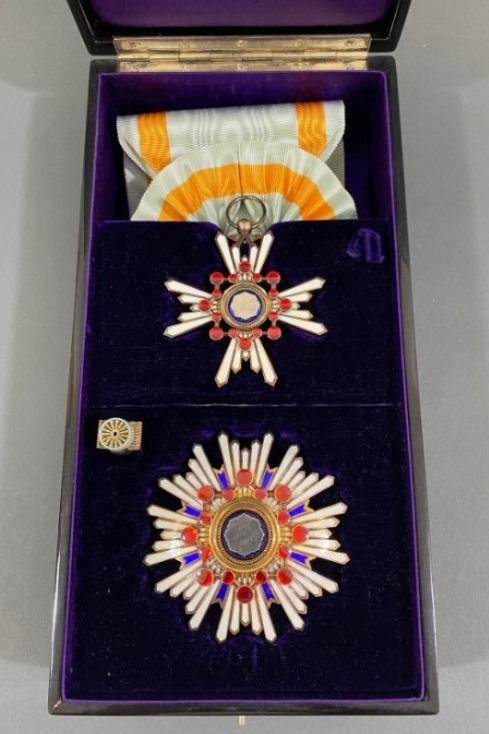
(1).thumb.jpg.38cff8cd9c5d55311a4208b0a83448ba.jpg)
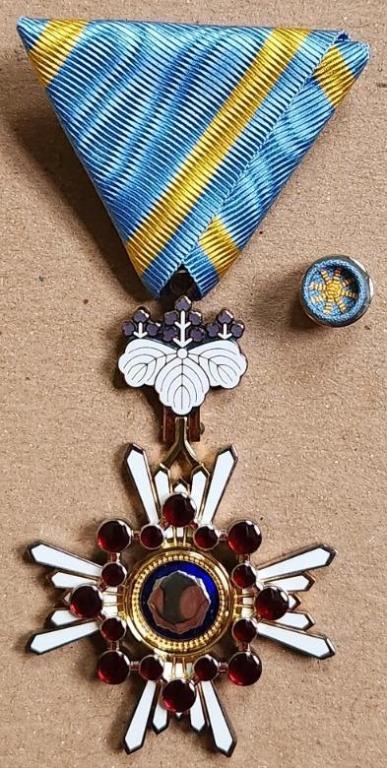

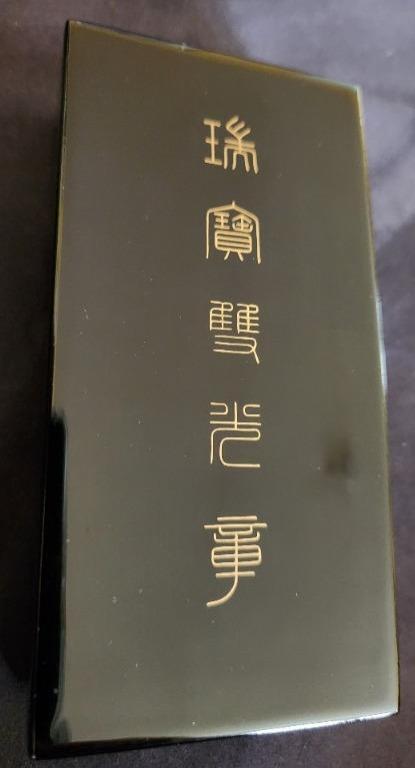
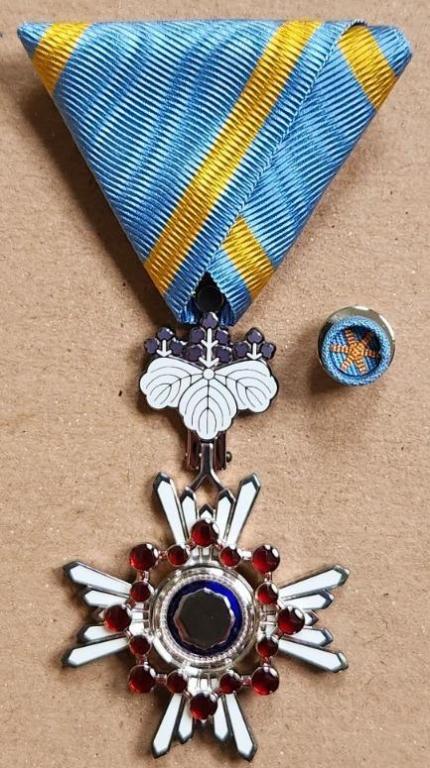


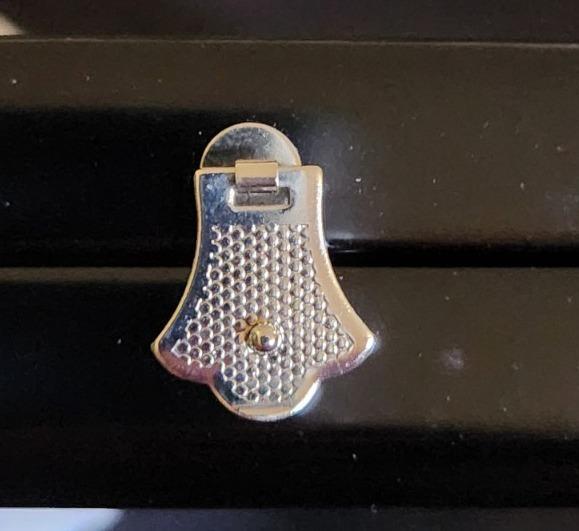
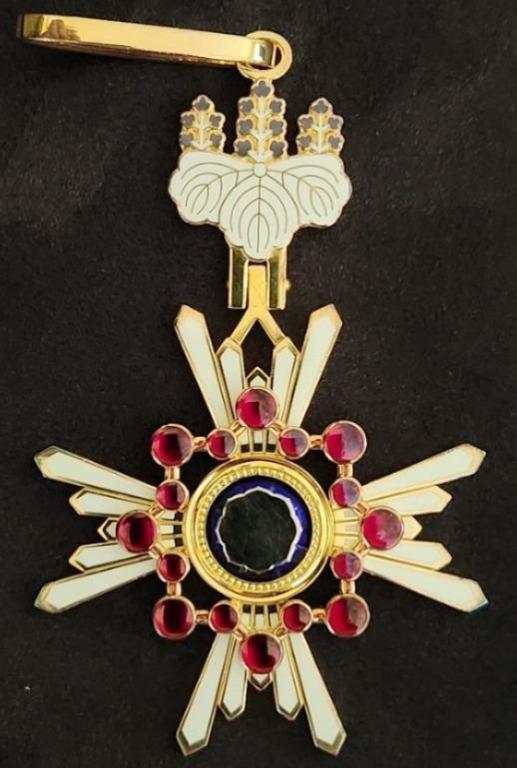

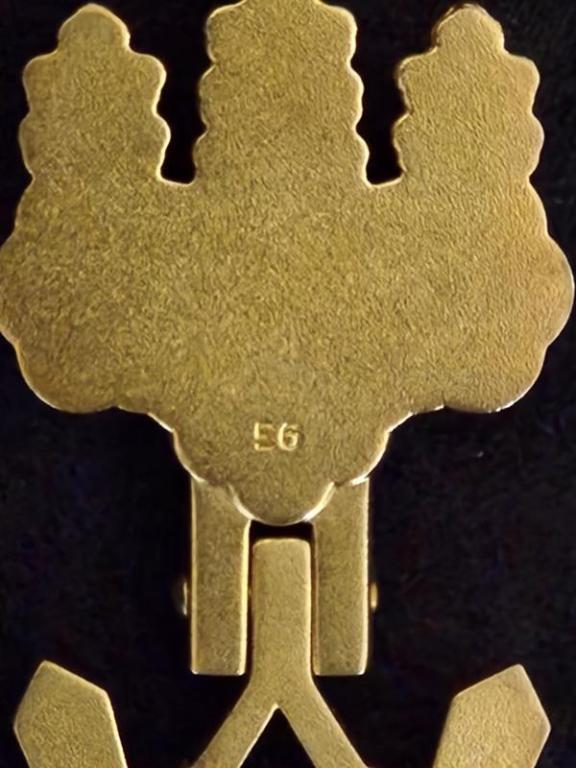
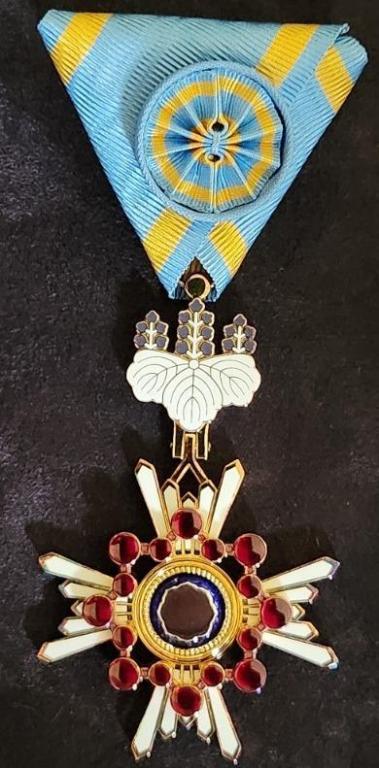
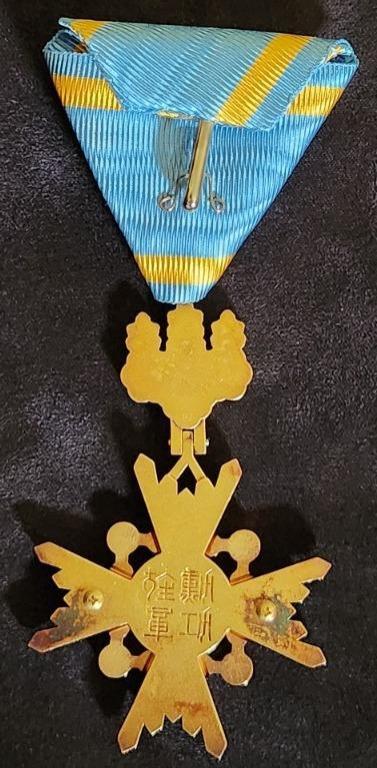


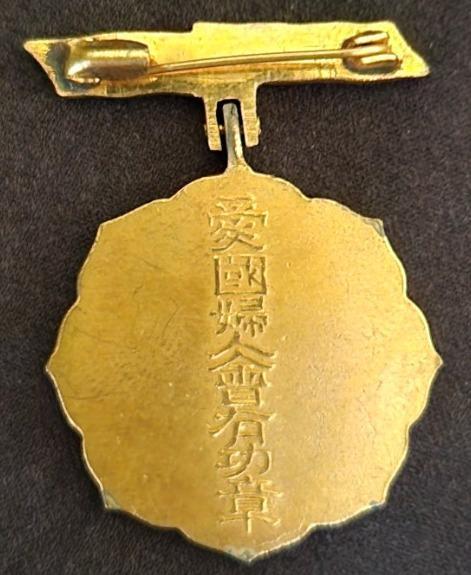
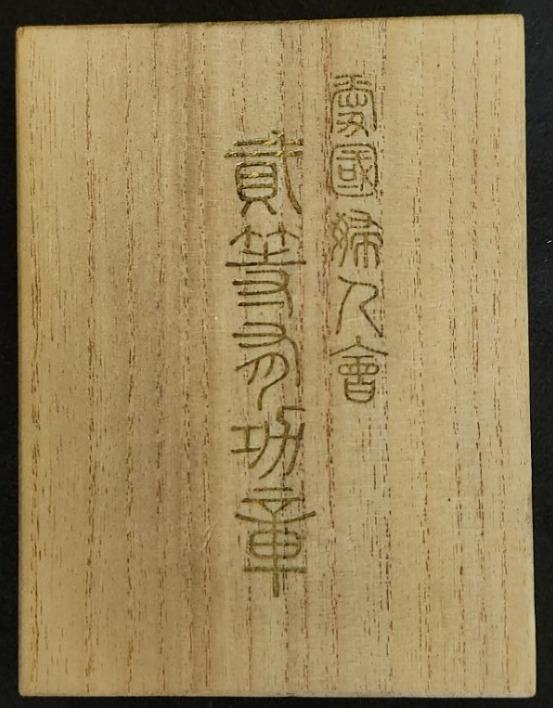

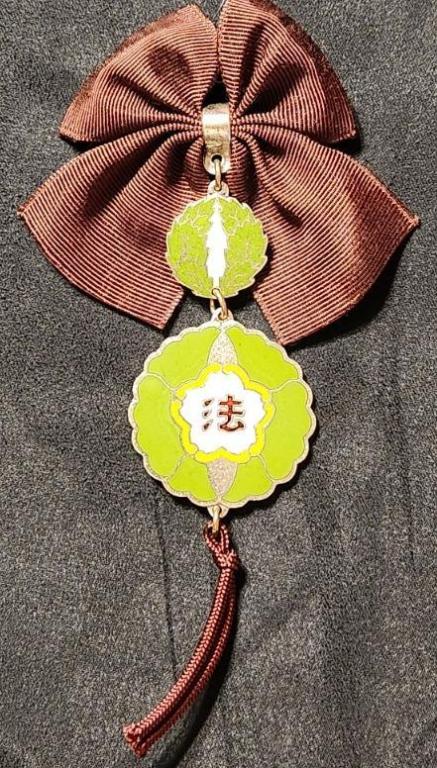

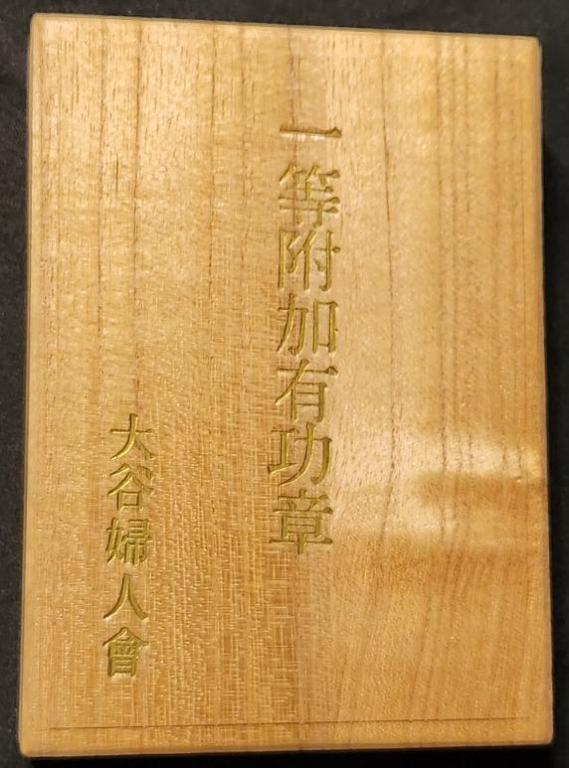


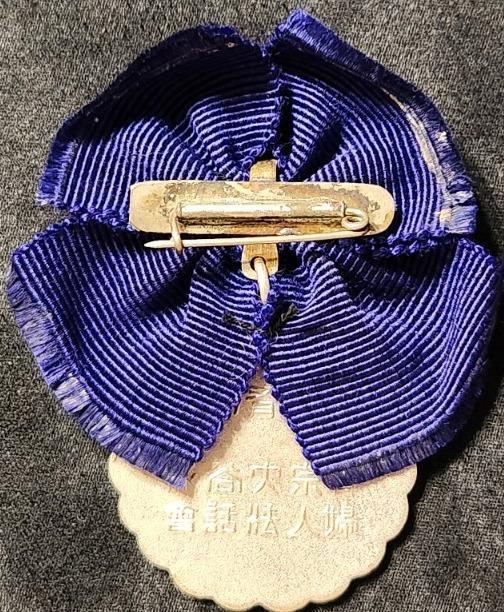

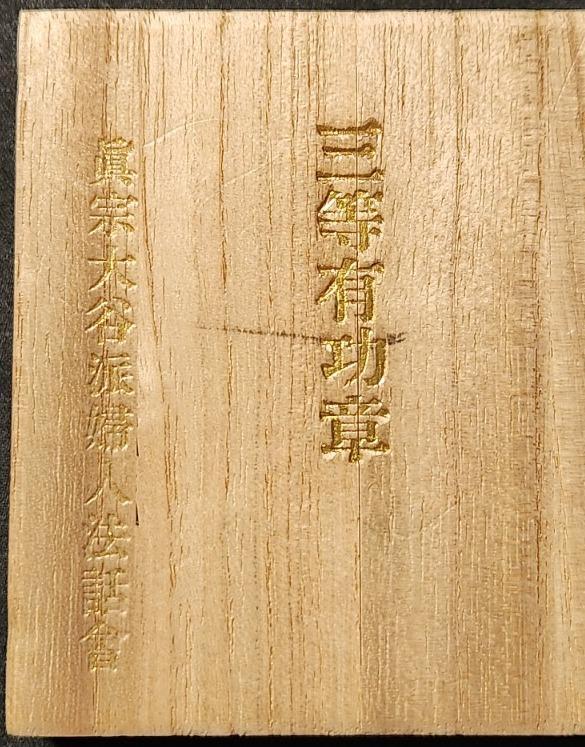
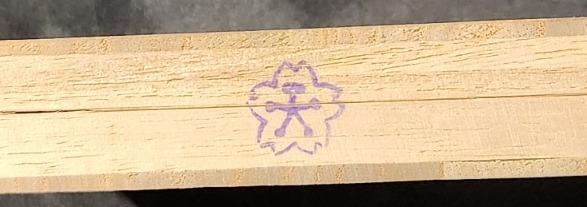
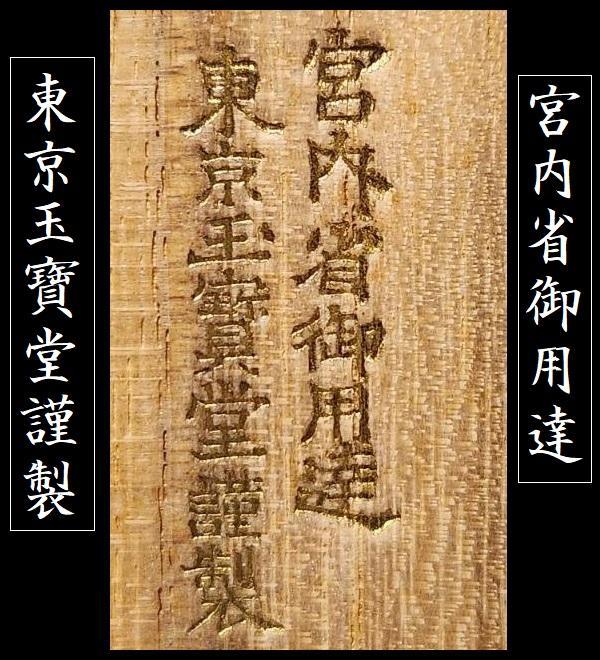

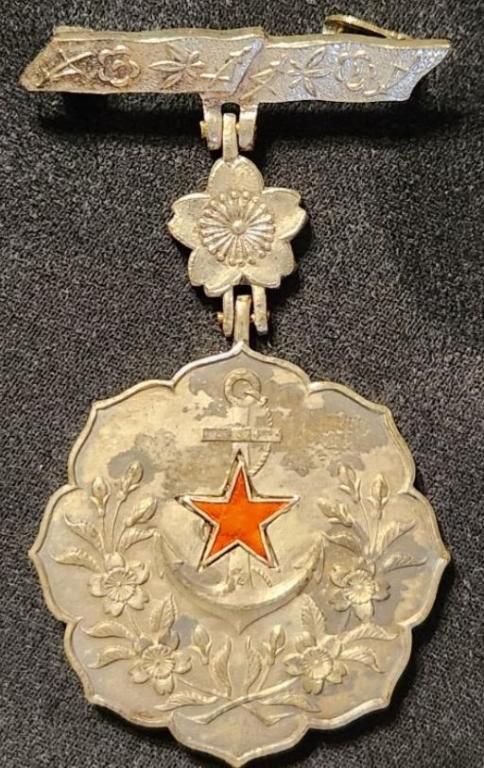
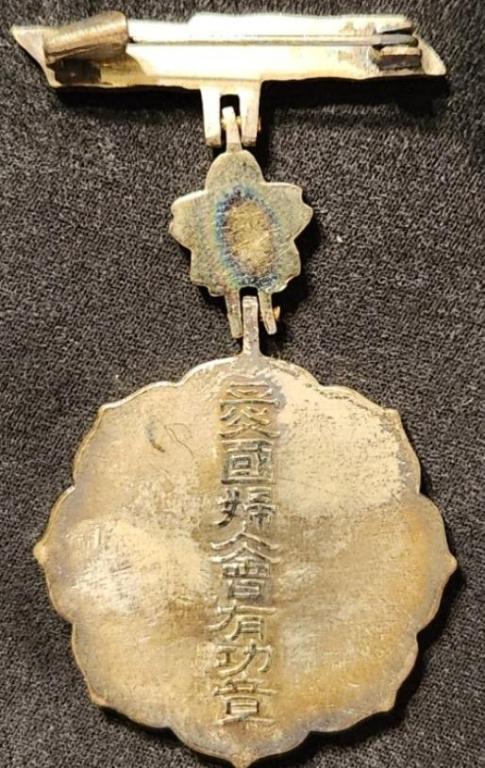
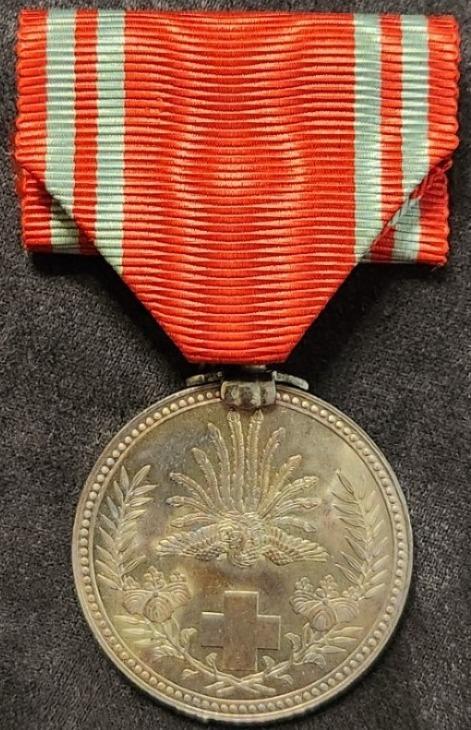


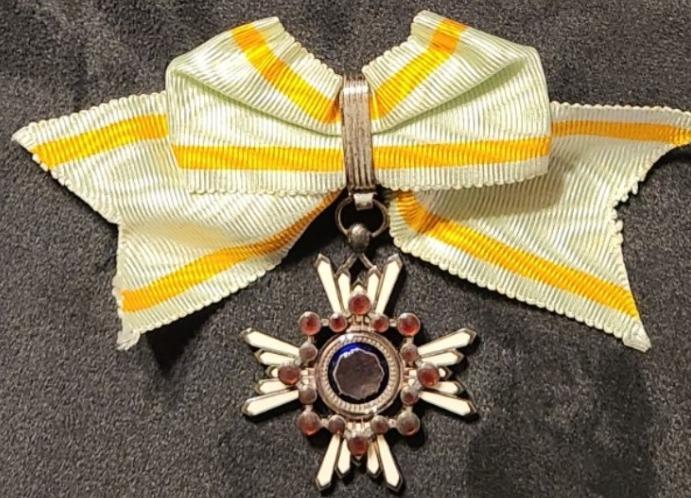
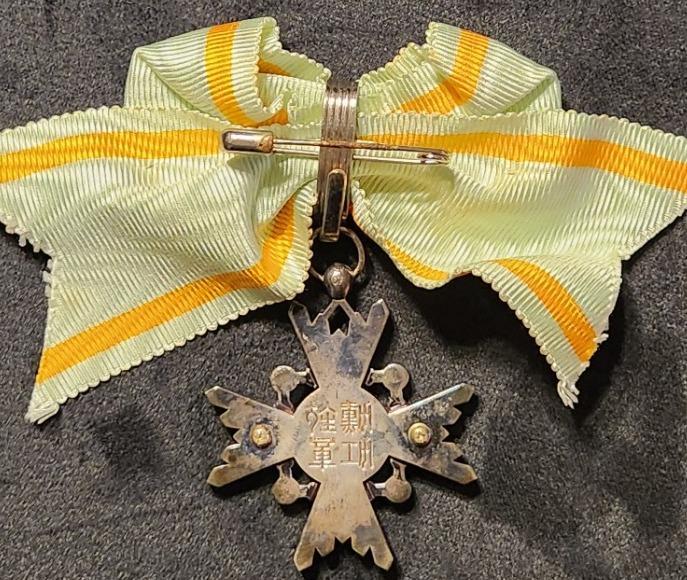

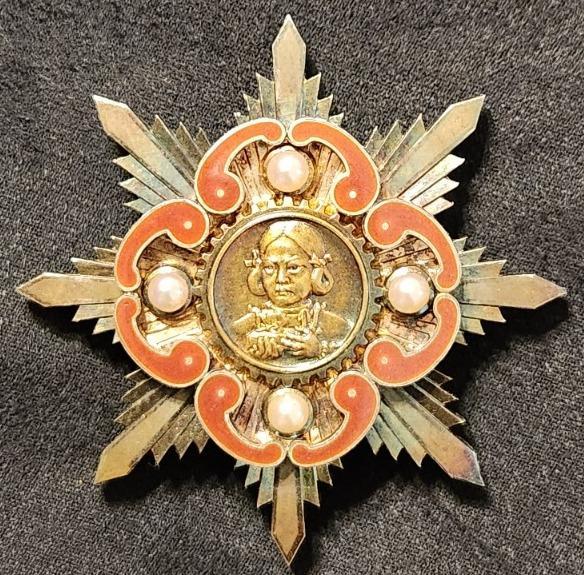
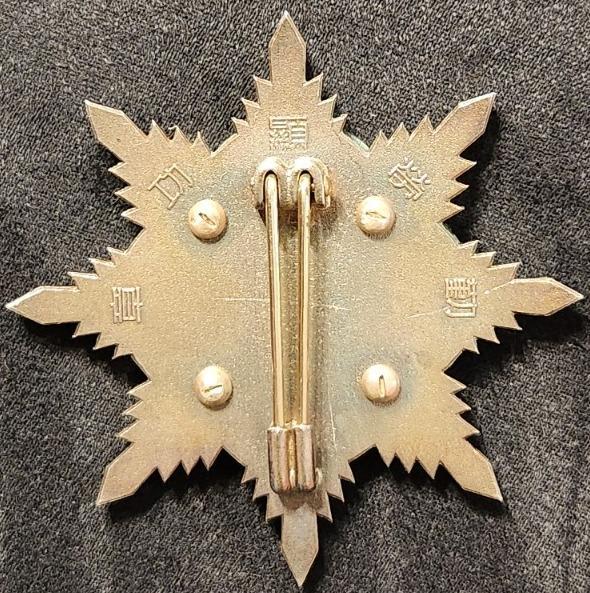
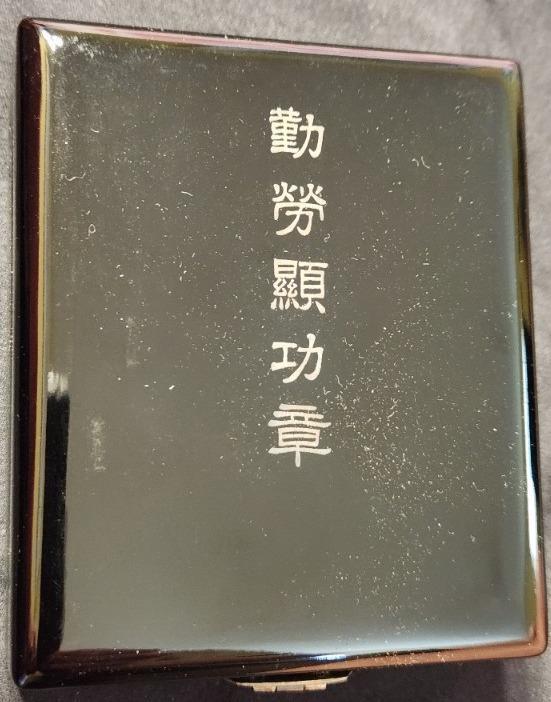
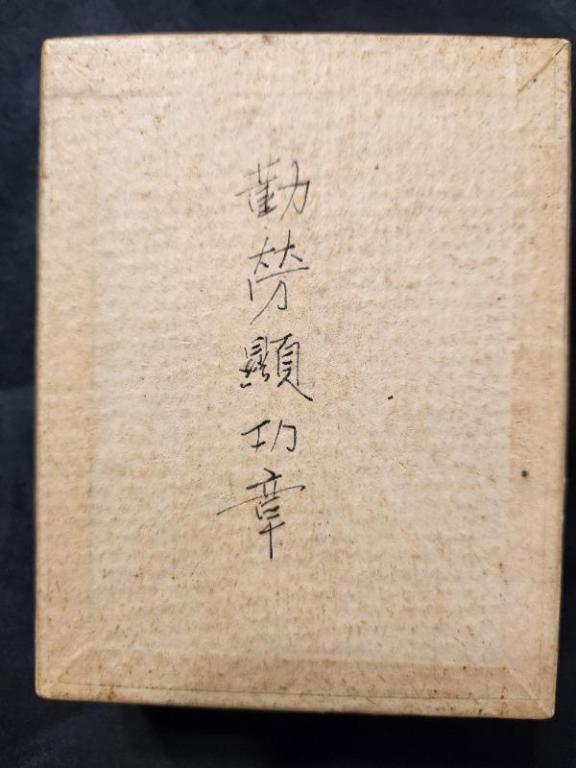
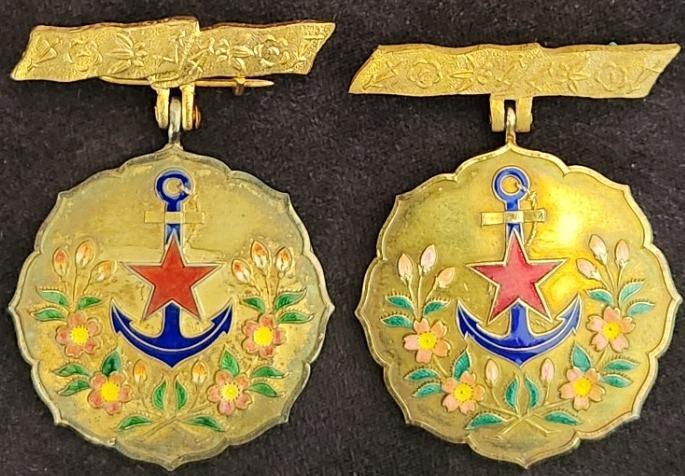
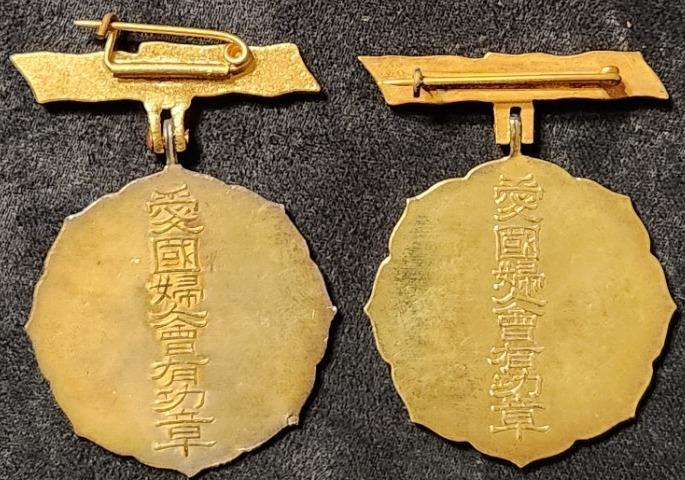


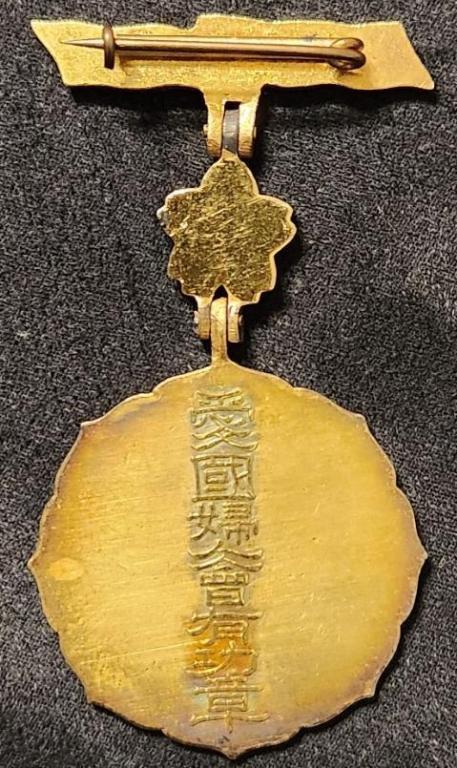
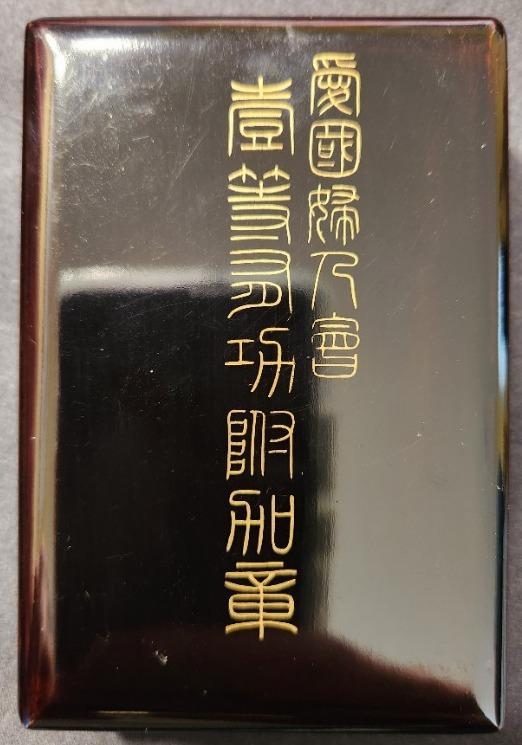
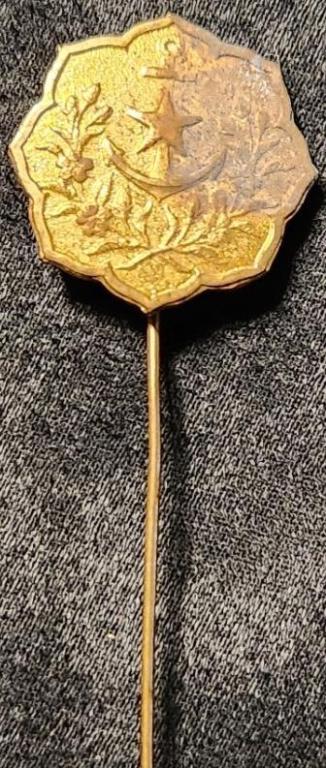

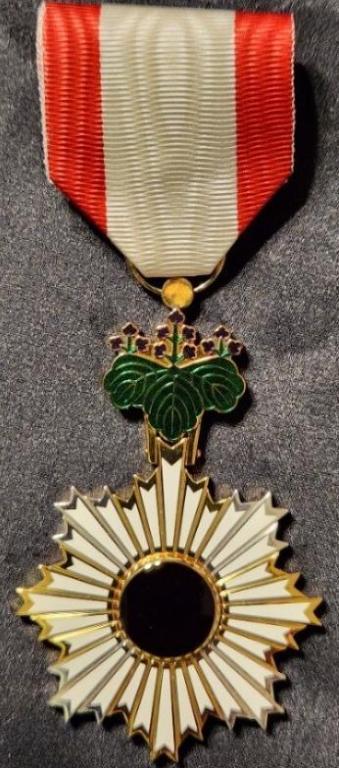

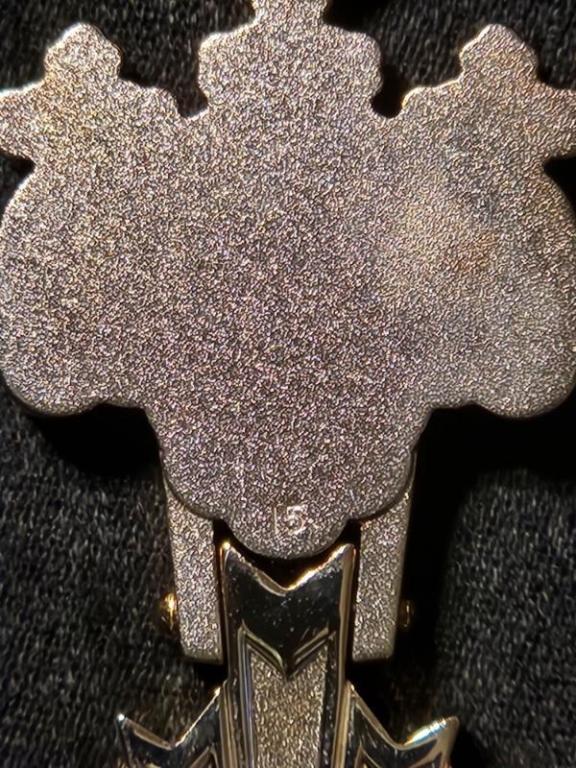
The Post-2003 Reform Order of the Sacred Treasure
in Japan
Posted · Edited by TracA
Accurate description of button lapel rosette; more accurate description of case interior
My third installment on this thread: The Order of the Sacred Treasure, Gold Rays with Rosette. Formally the 4th class in the pre-reform orders.
The triangular ribbon shape on my example is approximately 45mm at its widest part by 42mm long. The ribbon color looks like cornflower blue, but I have no idea what it is officially. 3mm from each ribbon edge is a 4mm gold stripe. Affixed to the front of the ribbon is a 22mm rosette of ribbon color with 10 pleats radiating out from the center, a circular gold stripe around the center, and another circular gold stripe 1mm from the outer edge.
The central design is per the pre-reform medal: the rays are enameled white, the paste jewels and their connecting lines are red (not enameled, but red glass?), and the mirror is polished silver on a dark blue enameled background. All other medal surfaces are gilt; nothing is silver in
color. Like the pre-reform medal, the width of the new medal is approximately 46mm from ray tip to ray tip. Since the post-reform medal has a new suspension the length is now approximately 67mm from the top of the 12h paulownia flower to the tip of either of the longest bottom two rays. The new suspension appears to be the same one used on the post-reform Order of the Rising Sun, Gold Rays with Rosette and up, the only difference being the color of the enamel on the obverse leaves and flower stems. On the OST Gold Rays with Rosette the three paulownia leaves and flower stems are enameled white and the leaves have gilt veins. The flowers are in a 5, 7, 5 configuration and are enameled light purple. The gilt colored medal fills in the spaces between the leaves and the stems. The piece on the suspension through which is threaded the metal ring attaching the ribbon is now shaped like a puck.
The entire reverse is gilt with a sandblasted looking finish. At approximately the midway point of the 3h and 9h arms is a phillips head screw, fasteners for the two piece construction. Like the pre-reform pieces, the four “order of merit” characters are arranged in a square in the center of the badge. Their recesses are, of course, gilt. The reverse of the leaves and flowers suspension device is flat and featureless; there is no detailed representation of the flowers and stems. My example has the hallmark BZ stamped on the bottom leaf at 6h. As of July 29, 2023 this hallmark is not listed on the wonderful Medals of Asia website at https://asiamedals.info/threads/two-letter-and-letter-digit-marks-on-japanese-orders-and-medals.13720/.
The case is lacquered black and I assume that it is made of wood. Given that the case for the Silver Rays is made of wood I would find it odd if the case for a higher award were not made of the same material. The dimensions of the case are as follows: approximately 65mm wide by 130mm long by 30mm high. The top and bottom are joined by a silver colored hinge at the back, fully visible when the lid is open, and the hinge is secured to the top and bottom of the case by three phillips head screws on each side. The lid is secured shut by a pin-and-hole silver clasp with a circle-next-to-circle design bordered by a smooth edge (see above OST Silver Rays for a picture). The inside top is of a purple colored satin like material, and the medalbed, recessed in the outline of the medal, is a purple colored velvet like material.
My example did not come with a button lapel rosette. However, zooming in on the picture of this order on the Wikipedia OST page it appears that the rosette is the same color as the ribbon, has eight “pleats” emanating from the center, and two circular gold stripes on the pleats: one around the center and one probably about 1mm from the edge.
Obverse:
Reverse (BZ hallmark is stamped on the bottom leaf at 6h):
Lacquered case lid with the script 瑞寶小綬章, Order of the Sacred Treasure Gold Rays with Rosette (or Order of the Sacred Treasure, Small Ribbon?):